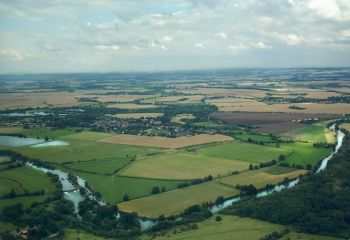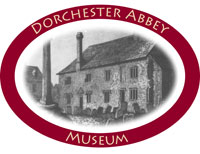History of the Area

The village of Dorchester-on-Thames lies in a loop of the river Thames at its confluence with the river Thame and is on a peninsula of second gravel terrace above the river floodplains. Today, the village is encircled by gravel quarries which are mainly lakes, giving Dorchester the appearance of sitting on an island. Indeed, over half the peninsula has been quarried away. These quarries were largely active from the 1940s, when one of the most important Neolithic and Bronze Age ceremonial centres in the British Isles was destroyed following only limited excavation of selected sites. Large areas between trenches were not explored, a number of monuments visible on air photographs were not investigated at all and there was very little environmental sampling. Excavations undertaken in advance of further quarrying and the construction of the bypass in 1981 examined the south-east terminal of the cursus and an early Neolithic enclosure and demonstrated the range of small, but important features which probably would have been present over much of the ceremonial monument had it been possible to observe the entire area. Aerial photographs show ring ditches and rectangular enclosures in the area between the cursus and the town and to the west of Bishop’s Court; the ceremonial complex may be more extensive than had been previously thought.
Dyke Hills is a remarkably well-preserved Iron Age oppidum of around 25 hectares to the south of the town, delimited by the Thames to the west and south, the Thame to the east and by impressive ditch and bank earthworks to the north. The dykes are largely intact, although levelled at their east end and riddled with rabbit burrows, the damage from which is a tangible cause of deterioration of the monument. Air photographs have revealed extensive remains of house circles, pits and other settlement evidence within the enclosed area. Traces of later Bronze Age and Iron Age settlement and field systems have also been discovered to the north of the dykes, in the gravel quarries at Bishop’s Court to the west and in the area of the cursus.

Dorchester is one of only two walled Roman towns known in Oxfordshire. The 2nd-century ramparts and later stone defences enclosed an area of c 6 hectares to the west of the river Thame. It was famously excavated by Professor Sheppard Frere in 1962-4 when traces of early Anglo-Saxon settlement were found above and cutting into the Roman levels, and other excavations have revealed similar evidence within the town. Extra-mural Roman settlement is known to lie the north of the town, some of which was destroyed by gravel quarrying and housing developments conducted without archaeological observation. Further settlement and a small group of burials have also been revealed to the west of the defences. Part of an extensive late Roman ‘managed’ cemetery, lying c 700 m north of the town, was excavated at Queenford Farm in 1972 and in 1981, in advance of gravel quarrying and road construction; another apparently similar cemetery on the other side of the Thame near Warborough may have belonged to the town. Both are possibly Christian. The late Roman inhabitants seem to have chosen to bury their dead at some distance from the town, a situation paralleled elsewhere in such places as Verulamium(modern St Albans) raising the possibility that funerary processions played an important role in late Roman burial practices.
Three nationally-important early 5th-century burials have been discovered at Dorchester, a man and a woman found in the Dyke Hills Iron Age ramparts and a woman from a gravel quarry next to the Minchin Recreation Ground. These individuals provide tantalising and in many ways unique evidence of society at the end of the period of Roman rule in Britain. The early 5th-century objects buried with them suggest that they were not merely Roman provincials and that the women at least may have come from north-west Germany. The female burials contained an intriguing combination of Romano-British and Germanic artefacts while the man seems to have been associated with the Roman military. Their wider context is absolutely key, yet remains unknown. Were they interred in a late Roman burial ground(s), or were they so-called 'founder graves' of larger Anglo-Saxon cemeteries? Radiocarbon determinations on five unaccompanied, west - east burials from the Queenford Farm cemetery indicate, remarkably, that the cemetery remained in use, along with the typically late Roman burial rites, through the fifth century and into the sixth, if not later. It would appear, based on this evidence, that several groups, with apparently very different identities, were living in close proximity in and around Dorchester in the 5th century.
In addition to the apparently early Anglo-Saxon settlement within the Roman town, Saxon sunken-featured buildings, a well and inhumation burials were excavated to the west of Bishop’s Court in advance of gravel extraction. Benson and Miles refer to nine Saxon inhumations cut into a prehistoric barrow near to the cursus and removed by gravel extraction.
Sometime near AD 635, Birinus established a bishopric at Dorchester, the first within the kingdom of Wessex. The see was transferred to Leicester in the late 7th century but returned to Dorchester in the 870s where it remained until after the Norman Conquest. In 1071, William I removed the bishopric to Lincoln, leaving the former cathedral site as a minster of secular priests and then, in due course, an Augustinian abbey. The present abbey church contains probable remains of the late Anglo-Saxon cathedral; excavations in 2003 north of the nave found mid-Saxon timber buildings, perhaps associated with the original cathedral foundation. Without the primacy of a bishopric, and with little secular power, Dorchester-on-Thames quietly carried on, leaving Oxford and Wallingford to develop more prominently.



